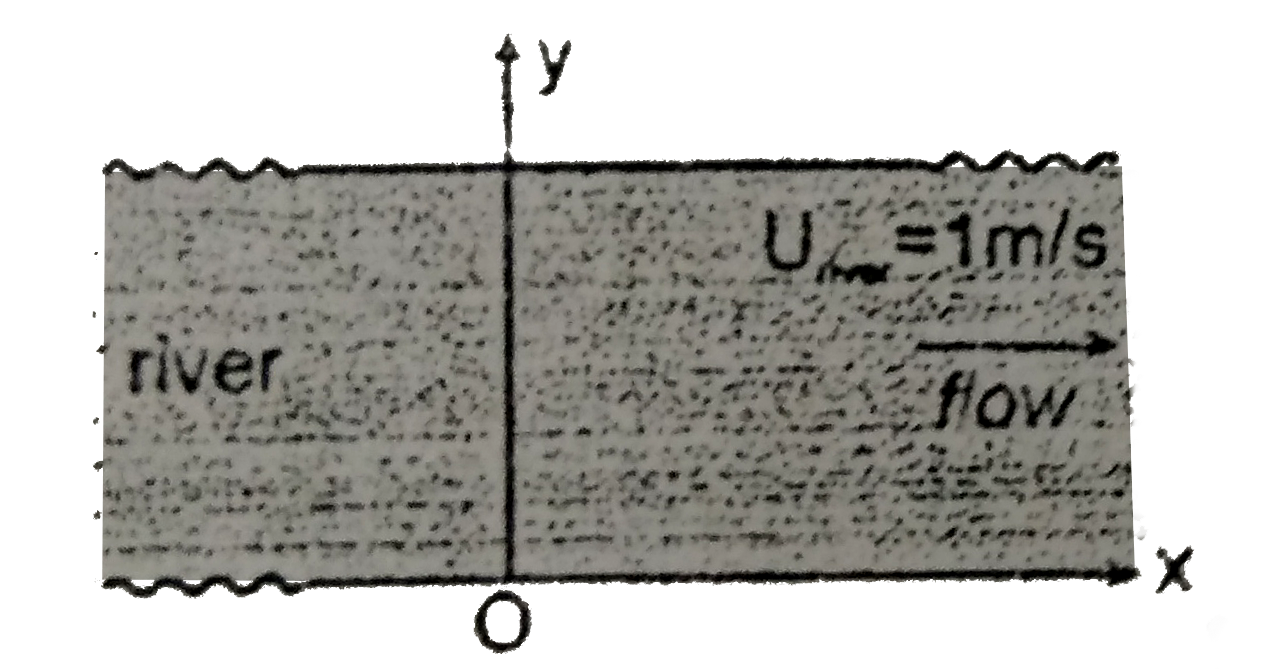A man runs at a speed of 4m/s to overtake a standing bus. When he is 6m beind the door at t=0, the bus mover forward and continuous with a constant acceleration of 1.2m/s2. The man reaches the door in time t. Then
√32
√34
√3
38
The correct Answer is:A
To solve the problem step-by-step, let's break it down into manageable parts.
Step 1: Understand the problem
We have a man running at a speed of 4m/s and a bus that starts moving from rest with a constant acceleration of 1.2m/s2. The man is initially 6m behind the bus door when t=0.
Step 2: Write the equations for the distances
1. Distance traveled by the bus:
The bus starts from rest and moves with constant acceleration. The distance db traveled by the bus in time t can be calculated using the equation:
db=12at2
where a=1.2m/s2.
Thus,
db=12×1.2×t2=0.6t2
2. Distance traveled by the man:
The man runs at a constant speed of 4m/s. The distance dm he covers in time t is given by:
dm=4t
Step 3: Set up the equation
At the moment the man reaches the bus door, the distance he has covered must equal the distance between him and the bus door plus the distance the bus has traveled. Therefore, we can write:
dm=6+db
Substituting the expressions for dm and db:
4t=6+0.6t2
Step 4: Rearranging the equation
Rearranging the equation gives:
0.6t2−4t+6=0
Step 5: Solve the quadratic equation
To solve the quadratic equation 0.6t2−4t+6=0, we can use the quadratic formula:
t=−b±√b2−4ac2a
where a=0.6, b=−4, and c=6.
Calculating the discriminant:
b2−4ac=(−4)2−4×0.6×6=16−14.4=1.6
Now substituting into the quadratic formula:
t=4±√1.62×0.6
Calculating √1.6≈1.2649:
t=4±1.26491.2
Calculating the two possible values for t:
1. t1=4+1.26491.2≈4.25
2. t2=4−1.26491.2≈2.29
Step 6: Conclusion
The time t at which the man reaches the bus door can be either 4.25 seconds or 2.29 seconds depending on the context of the problem.
We have a man running at a speed of 4m/s and a bus that starts moving from rest with a constant acceleration of 1.2m/s2. The man is initially 6m behind the bus door when t=0.
1. Distance traveled by the bus:
The bus starts from rest and moves with constant acceleration. The distance db traveled by the bus in time t can be calculated using the equation:
db=12at2
where a=1.2m/s2.
Thus,
db=12×1.2×t2=0.6t2
The man runs at a constant speed of 4m/s. The distance dm he covers in time t is given by:
dm=4t
At the moment the man reaches the bus door, the distance he has covered must equal the distance between him and the bus door plus the distance the bus has traveled. Therefore, we can write:
dm=6+db
Substituting the expressions for dm and db:
4t=6+0.6t2
Rearranging the equation gives:
0.6t2−4t+6=0
To solve the quadratic equation 0.6t2−4t+6=0, we can use the quadratic formula:
t=−b±√b2−4ac2a
where a=0.6, b=−4, and c=6.
b2−4ac=(−4)2−4×0.6×6=16−14.4=1.6
t=4±√1.62×0.6
Calculating √1.6≈1.2649:
t=4±1.26491.2
Calculating the two possible values for t:
1. t1=4+1.26491.2≈4.25
2. t2=4−1.26491.2≈2.29
The time t at which the man reaches the bus door can be either 4.25 seconds or 2.29 seconds depending on the context of the problem.
Topper's Solved these Questions
- MOTION IN A PALNEBOOK - ALLENCHAPTER - MOTION IN A PALNEEXERCISE - Comprehension#4
3 Videos
- MOTION IN A PALNEBOOK - ALLENCHAPTER - MOTION IN A PALNEEXERCISE - Comprehension#5
6 Videos
- MOTION IN A PALNEBOOK - ALLENCHAPTER - MOTION IN A PALNEEXERCISE - Comprehension#2
5 Videos
- KINEMATICS-2DBOOK - ALLENCHAPTER - KINEMATICS-2DEXERCISE - Exercise (O-2)
46 Videos
- NEWTON'S LAWS OF MOTION & FRICTIONBOOK - ALLENCHAPTER - NEWTON'S LAWS OF MOTION & FRICTIONEXERCISE - EXERCISE (JA)
4 Videos
Similar Questions
A student is running at her top speed of 5.0ms−1, to catch a bus, which is stopped at the bus stop. When the student is still 40.0m from the bus, it starts to pull away, moving with a constant acceleration of 0.2ms−2.
a For how much time and what distance does the student have to run at 5.0ms−1 before she overtakes the bus?
b. When she reached the bus, how fast was the bus travelling?
c. Sketch an x−t graph for bothe the student and the bus.
d. Teh equations uou used in part (a)to find the time have a second solution, corresponding to a later time for which the student and the bus are again at thesame place if they continue their specified motions. Explain the significance of this second solution. How fast is the bus travelling at this point?
e. If the students⊤speedis3.5 m s^(-1), will she catch the bus?
f. What is the minimum speed the student must have to just catch up with the bus?For what time and what distance dies she have to run in that case?
View SolutionA man in a balloon throws a stone downwards with a speed of 5m/s with respect to balloon. The balloon is moving upwards with a constant acceleration of 5m/s2. Then velocity of the stone relative to the man after 2 seconds is.

View SolutionA man is standing on a road and observes that rain is failing at angle 45∘ with the vertical. The man starts running on the road with constant acceleration 0.5m/s2. After a certain time from the start of the motion, it appears to him that rain is still falling at angle 45∘ with the vertical, with speed 2√2m/s. Motion of the man is in the same vertical plane in which the rain is falling. Then which of the following staement(s) are true.
View SolutionA man is 25 m behind a bus, when bus starts accelerating at 2ms−2 and man starts moving with constant velocity of 10ms−1. Time taken by him to board the bus is
View SolutionA man runs towards a mirror at a speed 15 m/s. The speed of the image relative to the man is
View SolutionA man is 45 m behind the bus when the bus starts acceleration from rest with acceleration 2.5ms2. With what minimum velocity should man start running to catch the bus?
View SolutionA man is at a distance of 6 m from a bus. The bus begins to move with a constant acceleration of 3ms−2. In order to catch the bus, the minimum speed with which the man should run towards the bus is
View SolutionAt t=0 and x=0 , an initially stationary blue car begins to accelerate at a constant rate of 2.0m/s2 in the positive direction of the x -axis At =t = 2s a red car travelling in an adjecent lane and in the same direction passes x =0 with a speed of 8.0m/s and a constant accleration of 3.0m/s2 .the time when red car passes the blue car is :
View SolutionA man can swim in still water with a speed of 3m/s x and y axis are drawn along and normal to the bank of river flowing to right with a speed of 1m/s. The man starts swimming from origin O at t = 0 second. Assume size of man to be negligible. Find the equation of locus of all the possible points where man can reach at t = 1 sec

View SolutionA man of mass 60 kg is in a lift and lift is accelerating upwards with acceleration 4m/s2. Calculate effective weight of man in lift.
View Solution
